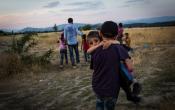Bosnia and Herzegovina Regional Office
Operation: Bosnia and Herzegovina Regional Office
Location
{"longitude":18,"latitude":44,"zoom_level":0}
Latest update of camps and office locations 13 Jan 2016. By clicking on the icons on the map, additional information is displayed.
Key Figures
| 2015 end-year results | |
| 60% | of households lived in adequate dwellings |
| 537 | households received core relief items |
| 759 | people of concern received production kits or inputs for agriculture, livestock, or fisheries activities |
| 90% | of primary school-aged children were enrolled in primary education, and 47% in secondary education |
| 2,456 | people of concern received cash grants, while 10,614 people with specific needs received non-cash support |
| 80% | of known SGBV survivors received appropriate support |
| 2,565 | people received psychosocial support |
| 6 | reception centre buildings were improved or maintained |
| 239 | people with undetermined nationality were assisted with confirmation of nationality and 2,111 people of concern had their naturalization facilitated |
| 413 | stateless persons assisted with acquisition of nationality |
| 2016 planning figures | |
| 85% | extent people of concern have access to legal assistance (target) |
| 100% | of households living in adequate dwellings (target) |
People of Concern
| 2015 | 442,321 |

[["Refugees",44535],["Refugee-like situation",171],["Asylum-seekers",1006],["IDPs",318326],["Returned IDPs",545],["Returned refugees",350],["Stateless",14129],["Others of concern",63259]]
Loading ...
Budgets and Expenditure for Bosnia and Herzegovina Regional Office
< Back
2015
{"categories":[2012,2013,2014,2015,2016],"budget":[null,null,null,61.005667061,68.42744073],"expenditure":[null,null,null,34.31168599,null]}
{"categories":[2012,2013,2014,2015,2016],"p1":[null,null,null,28.612472566,41.36723255],"p2":[null,null,null,3.844207253,3.47688212],"p3":[null,null,null,5.793305568,3.8070055],"p4":[null,null,null,22.755681674,19.77632056]}
{"categories":[2012,2013,2014,2015,2016],"p1":[null,null,null,20.24093268,null],"p2":[null,null,null,2.32336862,null],"p3":[null,null,null,2.02776035,null],"p4":[null,null,null,9.71962434,null]}
Loading ...
CHOOSE A YEAR
- 2015
- 2016
UNHCR’s Regional Office in Bosnia and Herzegovina covers activities in Albania, Bosnia and Herzegovina, Kosovo (Security Resolution 1244 (1999)), Montenegro, Serbia, and the former Yugoslav Republic of Macedonia. Additional information on UNHCR’s response in South-Eastern Europe is presented in the subregional overview.
In Albania, UNHCR continued to support the Directorate for Asylum to facilitate access to territory and status determination procedures for people of concern. Border monitoring missions were conducted regularly and relations with the Government continued to develop, including on issues of preparedness. In total, the Office facilitated the relocation of 482 residents of Hurriya, Temporary Transit Location in Iraq to Albania, bringing the number of individuals relocated to 821.
In Bosnia and Herzegovina, UNHCR focused on the implementation of the EU-funded multi-stakeholder project on the Revised Strategy for the Implementation of Annex VII of the Dayton Peace Agreement, as well as supporting solutions for IDPs. The project achieved results related to access to rights, social protection, self-reliance and housing. In an effort to align the country’s national legal framework with EU acquis, a new law on foreigners was adopted and a new law on asylum is in the final stage prior to adoption.
In Kosovo (S/RES/1244 (1999)), UNHCR advocated for improvements in access to and quality of status determination procedures, as well as improvements in reception conditions, with a particular focus on people with specific needs, including children and victims of violence. UNHCR contributed to the development of seven sub-legal acts (implementing regulations) and facilitated 17 capacity-building events, which benefited some 290 individuals. The Office also monitored reception conditions and detentions facilities. All asylum-seekers benefited from legal aid and psychosocial counselling. Some 500 people returned to Kosovo (S/RES/1244 (1999)) in 2015 with UNHCR’s assistance.
In Montenegro, UNHCR supported 1,200 refugees to obtain civil documentation, enabling the issuance of decisions for their foreigner applications. 150 people were assisted to return to their countries of origin and almost 4,000 refugees received various types of psychosocial, cash and non-cash assistance. Over 10,500 refugees out of 16,500 obtained foreigner status with permanent residency and 34 individuals at risk of statelessness received support in acquiring citizenship. Amendments to the Law on Non-Contentious Proceedings entered into force on May 2015 and provided improved access to late birth registration, particularly for children born outside of health facilities.
In Serbia, UNHCR developed a protection strategy in response to the influx of refugees and migrants to contribute to the development of a sustainable asylum system. This increased the refugee status determination recognition rate from 1.5 per cent in 2014 to 5.1 per cent in 2015 (16 out of 89 people who underwent the status determination process), but does not include the almost 600,000 who transited through Serbia to West Europe. UNHCR also advocated for a two-pronged approach to secure durable solutions for IDPs through voluntary return and local integration. The number of Roma at risk of statelessness decreased following improved cooperation with authorities.
In the former Yugoslav Republic of Macedonia, UNHCR’s main focus was on responding to the mass influx of refugees and migrants, mostly Syrians. Crucial amendments to the asylum legislation were adopted in June 2015, providing protection coverage to thousands of refugees and migrants at the point of entry and inside the country. The influx placed a substantial burden on the country’s limited asylum and migration framework, making it dependant on the support of UNHCR and its partners to ensure basic registration, information-sharing, as well as legal, social, and humanitarian assistance.

